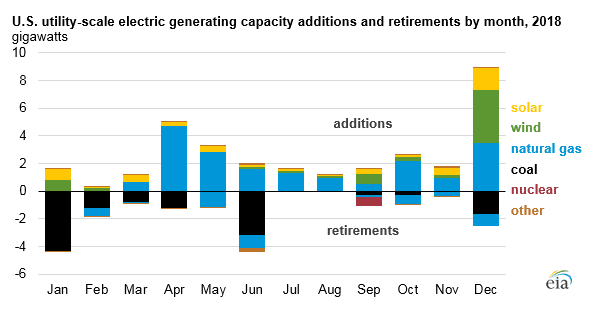U.S. Added Over 31 Gigawatts of Electric Generating Capacity in 2018, Largest in 15 Years: EIA

The U.S. added 31.3 gigawatts of generating capacity in 2018, the largest since the 2003 capacity addition of 48.8 gigawatts, according to a March 11 report from the Energy Information Administration. Natural gas accounted for 62 percent of utility-scale additions, while wind and solar photovoltaic represented 21 percent and 16 percent, respectively. Coal accounted for 69 percent of the 18.7 gigawatts that retired last year.
- Pennsylvania accounted for almost 25 percent of the natural gas-fueled additions last year, while Maryland, Virginia, and Florida had a combined share of about 30 percent.
- More than 60 percent of the 6.6-gigawatts of wind capacity that came online in 2018 was installed in Texas, Iowa, and Oklahoma.
- California, Florida, and North Carolina together added about 60 percent of the 4.9-gigawatt utility-scale solar photovoltaic installations last year.
- About 93 percent of the 4.7 gigawatts of natural gas-fired capacity retired was from steam and combustion turbine units, which are less efficient technologies that typically operate at lower capacity factors than combined-cycle units.
- New Jersey was the only state to retire nuclear capacity, the 600-megawatt Oyster Creek plant that closed in September 2018.
EnerKnol Pulses like this one are powered by the EnerKnol Platform—the first comprehensive database for real-time energy policy tracking. Sign up for a free trial below for access to key regulatory data and deep industry insights across the energy spectrum.
ACCESS FREE TRIAL